
An artist interprets the ancient city's most evocative artifacts
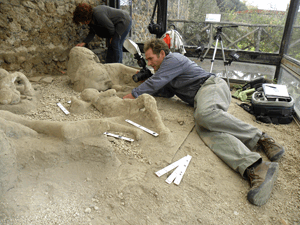
Artist Gary Staab measures and photographs the plaster cast of a small child in the "Garden of the Fugitives" in order to create a model of the original cast.
(Courtesy Lissi Staab)
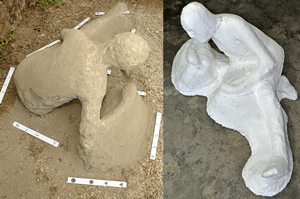
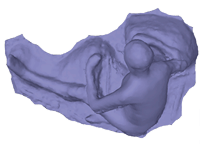
In order to create an accurate model of the original cast of what is commonly referred to as "Fiorelli's Merchant," the first step was to get precise measurements in his photographs. Staab employed specially made scale bars that are recognized by a 3-D modeling program called AgiSoft Photoscan.
The software then reconciled the hundreds of photos of the figure in order to create a 3-D image, which was then checked for accuracy against physical measurements made in the field. The data was sent to a computer-navigated cutter in Texas, which then milled the figure out of high-density foam.
(Courtesy Staab Family)
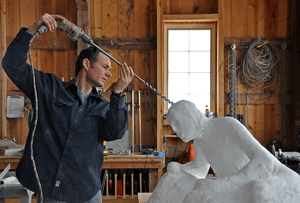
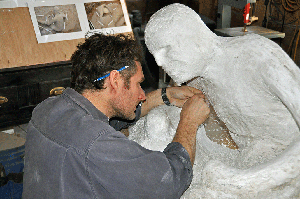
After the foam model was cut, Staab placed three steel rods inside in order to reinforce and stabilize it. Since the milling process captures the figure's overall shape but none of the subtle surface details, Staab coated the foam in a thin layer of plaster. He then sculpted in the details so that his model matched the appearance of the original cast as closely as possible.
After all the fine detail work was completed, Staab saturated the model with an industrial-strength epoxy resin to increase its durability. Finally, the "Merchant" was painted, crated, and sent to New York for the Pompeii exhibition.
(Courtesy CW: Owen Staab, Toby McFarland Pond, Max Staab)
During excavations in Pompeii in the mid-nineteenth century, Italian archaeologist Giuseppe Fiorelli began to encounter voids in the solidified ash and pumice from the eruption of Mount Vesuvius that had buried the town in A.D. 79. By pouring plaster into the voids and removing the fill around the plaster after it had hardened, Fiorelli discovered that the voids were in fact the spaces left by the decomposed bodies of Pompeians killed by the volcano. As soon as they came out of the earth the plaster casts became direct evidence—artifacts, not just records of artifacts—of these people at the particular moment of their deaths. The casts, and dozens of others made since, using the same technique, also became iconic symbols of the human toll the eruption took that day.
Almost 150 years after Fiorelli made his first cast, artist Gary Staab was commissioned to make models of four original Pompeian casts for a special exhibition on Pompeii in New York ("Vesuvius Strikes Again," May/June, 2011). In doing so, Staab created a new type of evidence. His models record not only these individuals' deaths, but also the context in which the original casts were fashioned by Fiorelli and later archaeologists. Staab's models are not precise replicas of these earlier casts, but rather interpretations of them. They are a product of technologies and materials not previously available and also of Staab's own input as an artist.
Staab is known for creating some of the world's most impressive museum models, bringing life to dinosaurs and Inca sacrificial victims, and for having made the only replica of King Tut's mummy. And while he was aware of the Pompeii casts, he had never seen them in person or been to the site. Staab recalls, "As soon as I got there, I was just blown away." He had only three days to do all his fieldwork. Apart from the necessary tasks of measuring and photographing the originals, being on-site in Pompeii was crucial to Staab. "It's really important to me to get a sense of place. The best thing you can do to understand someone, to relate to them, even after they are gone, is to try to walk in their shoes and to see what they saw," he says. "The beauty of it all is on the human level as you lie in the dust where these people died. I was crawling on the ground and lying in the pumice with small bits of artifacts and rubble under me," Staab adds. Just as Fiorelli may have done.
Before he went to Pompeii, Staab looked at old photos that showed some of the casting techniques. But actually seeing the casts gave him the insights he was after. "When I got there, I tried to put myself in the minds of the original casters because it really helped me understand how these casts were made," says Staab. For example, he learned that in the areas where there is only a little flesh covering the bones, like fingers and toes, only a small amount of plaster was able to make it into those spaces after the flesh decayed. The original casters had to fill those parts in a second time, and the plaster pooled up, obscuring the shape of the hand or foot. This explains the blocky look of many of the casts' extremities. In addition, several of the casts showed evidence of a post-excavation patch job in the spot where the archaeologists had made a hole through which to pour the plaster.
Visiting Pompeii helped Staab determine the technique he would use to create his own models once he returned. They would be made of high-density foam, reinforced with steel rods at their core. Although Staab had initially planned to coat them using a plastic resin–like material to reproduce surface details, he changed his mind. "I decided that nothing looks more like plaster—than plaster." After Staab made the foam models, he coated them then, with a thin layer of plaster and tooled in the details to match the original. "My job is to be as true to the artifact as possible," explains Staab. "Although it's inevitable that some of the artist's hand is shown in the surface details, I do my best to keep a faithful eye and a steady hand when it comes to capturing and producing a model." For example, he tried to reproduce even the patches that covered the holes into which the plaster had been poured.
Staab believes that the nature of his work allows him to connect with the past in an intimate way. "I am a person with a highly active imagination and there's a lot of emotion, whether it's looking at Aztec sacrificial knives, Olduvai Gorge pebble tools, or the people of Pompeii. They all carry their own weight, if you will, as artifacts." And the models that Staab has created will now also become part of the archaeological record.
Jarrett A. Lobell is executive editor of ARCHAEOLOGY.
Advertisement

Advertisement







